“Where are the lions?” is the question we, and most other visitors and safari guides, are asked in African national parks! The majority of visitors want to see and photograph the big cats, with lions being at the very top of that list as they are fearsome predators.
In order to successfully photograph lions you need to know where to find them and you need to understand their behavior so that you can anticipate action. You need to have at least a DSLR camera with a telephoto zoom lens and know how to use them.
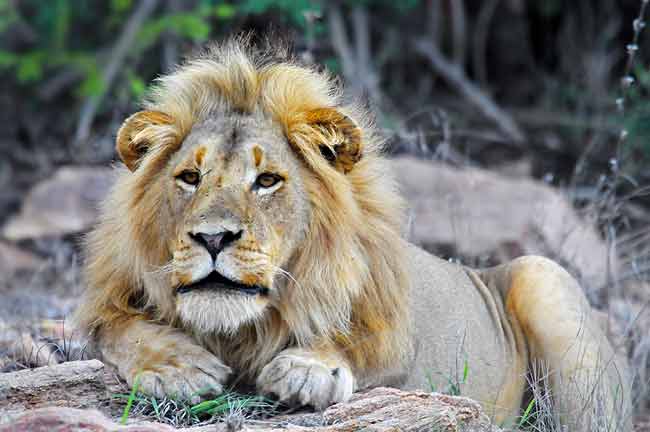
Lions can be found in most African national parks, but the best parks tend to be in east Africa (Serengeti in Tanzania and Masai Mara in Kenya) and southern Africa. Safaris in east Africa can be expensive so this article will focus on the southern African parks that cater for all budgets and offer the choices of guided safaris or self-drive safaris.
These parks are the Kruger National Park, Kgalagadi Transfrontier Park and the Pilanesberg National Park in South Africa, and the Etosha National Park in Namibia.
ABOUT LIONS:
Most likely a visitor will see lions in the Southern African parks of Kruger, Kgalagadi, Pilanesberg, and Etosha, as they are accustomed to vehicles and have little fear of the spectators.
We have found many lions by watching the prey animals. Keep in mind that warthogs, wildebeest, zebra, giraffe, impala, kudu, and all the other antelope species are what the lions want to eat, so of course, they tend to be in the areas where the next meal is accessible.
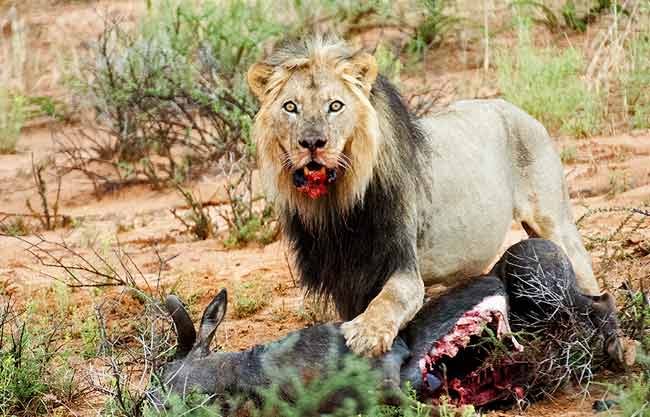
We have often stopped to watch a bird or buck and have spotted a lion hiding behind a rock or a bush. While we then get ready in anticipation of photographing a chase or kill, many other vehicles just drive past us as they think we are watching the prey!
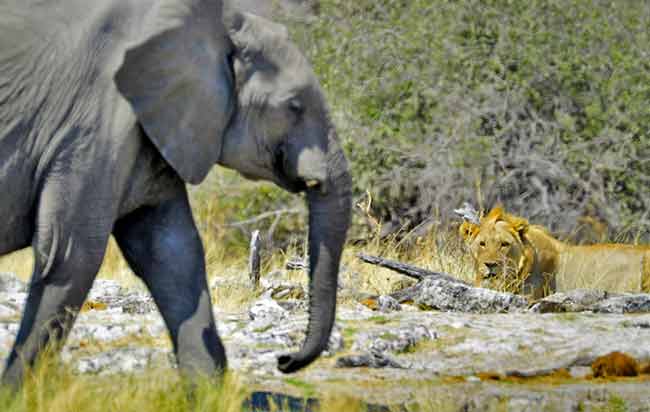
Sometimes you will see the lion stalking the prey and other times the prey will alert you to the fact that there is a lion nearby. They do this by going stiff, staring in one direction, snorting and/or running away, depending on which prey animal it is.
During the winter months lions tend to lie in the roads, both for warmth and because they don’t like the wet dew on the grass. Early mornings provide a good chance of finding them walking or lying in the roads.
You could see lions at any time of the day, but your best chances are between late afternoon and early morning. They tend to sleep for most of the day (in the shade under trees) and when the day starts to cool down they begin to arise. This is your opportunity to make images that depict stretching, greeting and yawning activities; all performed before they go hunting.
Lions tend to hunt at night, so if you go on a night drive you may get to see them stalking, chasing, or making a kill. In the early morning you may get to see them with the remains of their kill or quenching their thirst at a waterhole.
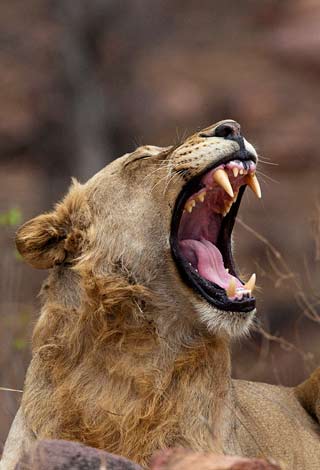
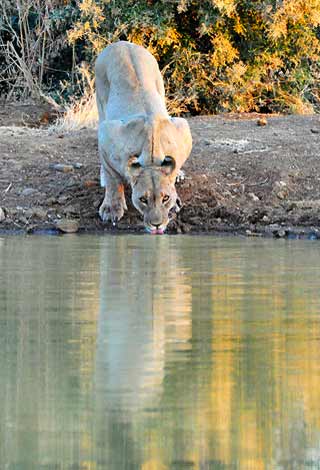
Some other behaviors to watch for are roaring, snarling, grooming, or spraying of urine (marking their territory).
Watch out for their body posture; flick of the tail, set-back ears or that intense stare. These gestures will let you know that something is about to happen. Always be ready for the unexpected!
When prey is abundant they’ll lounge during the day, but when prey is scarce or the days are cool, lions could hunt anytime. The females do most of the hunting, while the males will help bring down the larger prey, like a buffalo or giraffe.
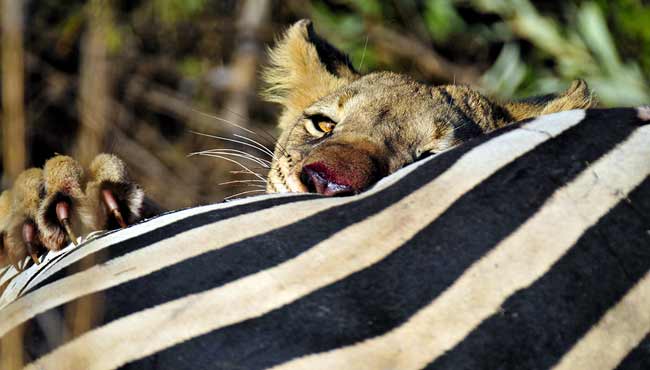
Mating lions make for good action images as well. The pair mates a few times per hour and for three or four days at a time. After the action the female turns to swat the male and he jumps back to avoid the female’s claws.
If you come across a pride of lions you will have many subjects on which to focus. If there are cubs, try to keep them in your image frame and pan with them as they move about. They get into all kinds of mischief; love to rough and tumble with each other or even pick on one of the adults.
Here’s your chance to get great action photographs of not just the cubs, but the adults disciplining a cub.
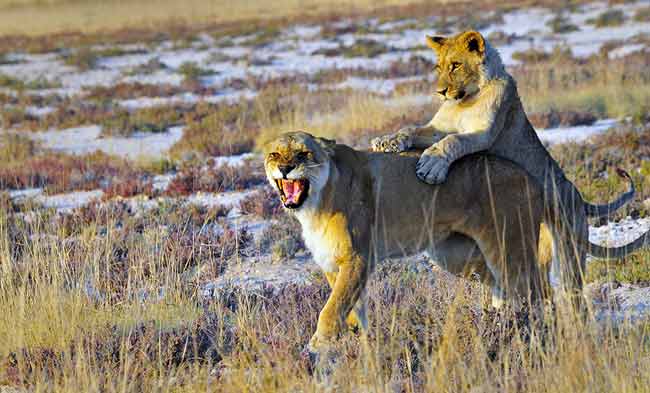
After a kill you will get the obvious jostling between individuals, but keep a lookout for other animals as well, such as hyenas, jackals and vultures. They won’t be far away. Often we have seen the hyenas chasing the lions from the kill or the lions chasing the hyenas away.
Once the lions have finished and moved off the carcass, don’t leave, as this is when the scavengers move in and you get interaction between them as they fight over the remains of the carcass. Nothing of the kill will go to waste.
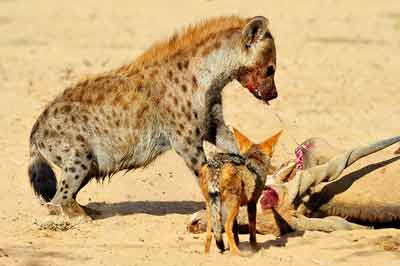
WHAT PHOTO GEAR IS NEEDED?
We have photographed lions with lenses ranging from a fisheye lens (yes, lions can get close to the vehicles!) to a 600mm f4 lens and lenses in between. Most of our lion images have been captured with telephoto lenses, such as the Nikon 80-400mm, 200-400mm f4, 80-200mm f2.8, and 600mm f4 lenses.
The lioness below was just five meters from our vehicle and we used a 600mm lens to capture this tight portrait. The image is not cropped.
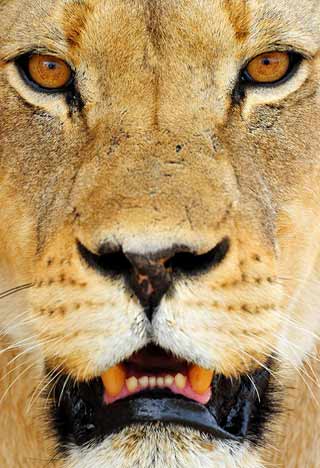
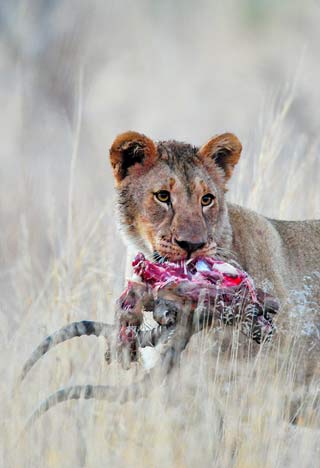
We use beanbags whether we are doing a self-drive or a guided safari. We use a panning plate on an Apex beanbag and have found that to be a better combination than a window bracket and gimbal head. If we are photographing from the camps then we will use a tripod and gimbal / ball head.
Should we need to use a gimbal head while in the vehicle, the Apex beanbag allows us to attach it.
Most lion activity happens under low light, before the sun has risen or after the sun has set, so you will need a camera such as the Nikon D3S or D800 to enable you to get images using high ISO with low noise. The lion cub below was photographed before sunrise, so we used ISO 12800 in order to ensure no blurring and the widest aperture.
Technically, lions are not difficult to photograph. They are large subjects and could be in prides that provide you with many individuals,so a long lens isn’t a necessity unless they are far off.
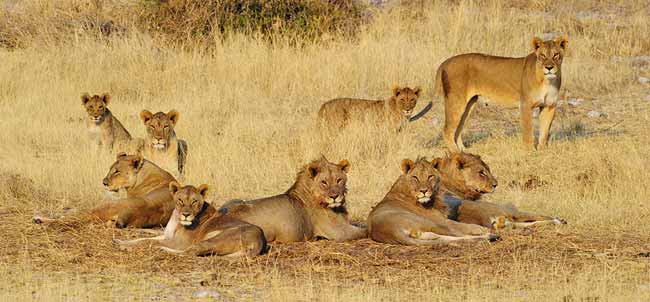
We enjoy staying at camps that allow us to photograph subjects by day or night from the comfort and privacy of our own chalets. This includes most of the camps in the Kgalagadi, Etosha, Kruger and Pilanesberg national parks.
We use a standard Nikon SB-900 flash with Better Beamer for most of our night photos. Many camps have floodlit waterholes, but for those that do not, we use a Lightforce spotlight that is excellent for waterholes up to 300 meters (984 feet) away!
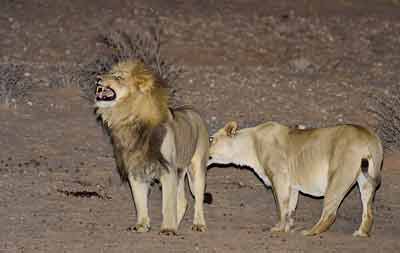
In terms of exposure lions are middle-tone, so matrix or evaluative metering should provide an accurate exposure.
Come to Africa and enjoy a safari and photo adventure you’ll never forget!
ABOUT THE PARKS:
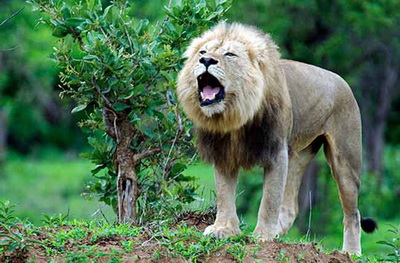
The Kruger National Park
Location: The Park is situated in north-eastern South Africa, bordering Mozambique and Zimbabwe.
Access: By road or by air. The park is about 400 kilometres from Johannesburg and OR Tambo International Airport. The road to Nelspruit and the southern Kruger Park is in good condition as is the road to the northern Kruger Park and the Punda Maria gate. There are also daily flights from Johannesberg to Phalaborwa and Hoedspruit Airports and the new Kruger/Mpumalanga International Airport (KMIA).
Management: South African National Parks (SANParks)
Facilities: There are over 20 park camps with accommodation ranging from camping, tents and chalets to large family cottages and guest houses. In addition, there are five-star lodges in concessions within the park and in private game reserves outside the park.
The roads in the park are in very good condition and the shops are very well stocked. The quality of the restaurant food tends to be average so braaing (BBQ) is recommended. However, the food in the private lodges is very good.
Reservations: Can be made online on the SANParks website and directly with the private lodges.
Best Viewing Times: Lions can be seen anytime of the year with March to December being recommended as January and February tend to be the months that the Kruger Park has floods and we want you to be safe!
The southern and central Kruger (from Berg en Dal and Crocodile Bridge camps in the south, up to Satara camp in the centre) have the highest lion densities so they tend to be seen more often. In winter lions can most often be found at or near the waterholes and dams.
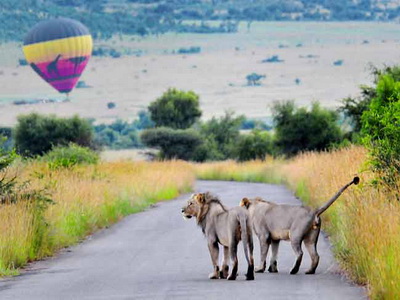
Two Male Lions Walking in Road
Pilanesberg
Nikon D300, Nikon 80-400mm lens @ 220mm on Apex beanbag
ISO 1600, f/5.6 @ 1/60 sec.
Pilanesberg National Park
Location: The Park is situated in the North-West Province of South Africa in the remains of a collapsed volcano.
Access: By road or by air. The park is just 150 kilometres from Johannesburg and OR Tambo International Airport. The roads leading to the park tend to be in good condition. The Pilanesberg International Airport is adjacent to the park and just a few kilometers from the Kwa Maritane gate.
Management: Northwest Parks
Facilities: There are seven lodges in the park ranging from three to five stars and the accommodation ranges from camping, tents and chalets to family chalets. The Black Rhino Reserve is situated on the north-western boundary of the park and there are a few commercial lodges there such as Pilanesberg private Lodge. There are tar and gravel roads in the park, generally in good condition. The shops have the basics and each lodge has a restaurant.
Reservations: Can be made online with the various lodge groups – Legacy Hotels, Golden Leopard, Pilanesberg Private Lodge (Black Rhino Reserve) and African Anthology.
Best Viewing Times: Lions can be seen anytime of the year. The winter and spring months (June – November) provide the best photo opportunities due to the short grass and veld fires. Lions tend to be found most often near water sources such as the various dams and Lake Mankwe.
Kgalagadi Transfrontier Park
Location: The Park is situated in South Africa in the Northern Cape along the Namibia and Botswana borders.
Access: By road or by air. The park is about 980 kilometres from Johannesburg and OR Tambo International Airport. The road to the park via Upington is in good condition as is the road from Cape Town. The nearest airport is in Upington where you can then hire a car and travel just 300 kilometres to the park.
Management: South African National Parks (SANParks) and Botswana Department of Wildlife & National Parks (DWNP).
Facilities: There are three main camps, six wilderness camps, and one luxury camp on the South African side and three luxury camps on the Botswana side. The accommodation ranges from camping, dune cabins and chalets to large family cottages as well as the luxury lodges in the park. The roads in the park are not sedan-friendly so a 4×4 is recommended. The shops are not well stocked so try and bring your necessities with you. There is just one restaurant in Twee Rivieren camp, which does not serve good food but the food in the private lodges is very good.
Reservations: Can be made online on the SANParks website or directly with the private lodges; Transfrontier Parks Destinations in South Africa (!Xaus Lodge) and Ta Shebube in Botswana (Rooiputs, Polentswa and Union’s End Lodges).
Best Viewing Times: Lions can be seen anytime of the year. However, late winter and spring months (August – November) provide the best photo opportunities due to the short grass. Lions can to be found in the Nossob and Auob riverbeds for most of the year, while in winter they tend to move into the dunes where it is warmer. The lion hotspot camps tend to be Urikaruus, Mata Mata, Rooiputs, Nossob, Gharagab, and Grootkolk. We have photographed lions from our chalets in all these camps.
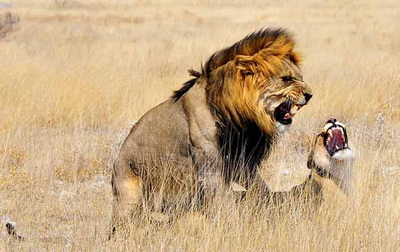
Etosha National Park
Location: The Park is situated in northern Namibia on a huge salt pan.
Access: By road or by air. The park is about 400 kilometres from Windhoek and Hosea Kutako International Airport. The national roads leading to the park are in good condition.
Management: Namibia Wildlife Resorts (NWR) and Ministry of Environment & Tourism (MET)
Facilities: There are five camps in the park and private lodges outside the park near the Anderson and Von Lindquist gates. The accommodation choices are camping, chalets and family chalets. The roads in the park are all gravel but tend to be in good condition. The shops have the basics and each camp/lodge has a restaurant and the food is generally good.
Reservations: Can be made online via NWR and with the various private lodges.
Best Viewing Times: Lions can be seen anytime of the year. The hotspot lion waterholes tend to be Dolomite, Rateldraf, Okondeka, Nebrownii, Okaukuejo, Homob, Salvadora, Goas, Rietfontein, Chudop, Kalkheuwel, and Klein Okevi. The dry winter and spring months (June – October) provide the best photo opportunities as the animals are drawn to the waterholes and you don’t have to go looking for them!
For more information on these four national parks, you can download a free 100-page Southern African Safari Guide when you subscribe to the Lion’s Roar Newsletter.
by Mario Fazekas
All text & photos: © 2013 Mario Fazekas. All rights reserved.

Leave a Reply